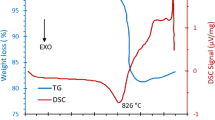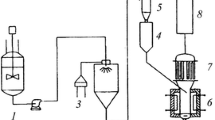Abstract
Tungsten carbides, which can be widely used for cutting and drilling tools, chemical catalyst and aerospace coatings, have attracted widespread attentions. However, the cost of conventional processes to produce tungsten carbides can be very high, therefore, there is a permanent effort to synthesize WC powder at low temperature to minimize the production cost. Some novel processing techniques have been developed to partially solve this problem. This paper reviewed the current research trends in preparation of WC containing spark plasma sintering, combustion synthesis, sol-gel and in situ carburization method, chemical vapor reaction synthesis and the spray conversion process, etc. The present review also discussed the potential applications, the feasibility, the advantages and disadvantages of industrialization.
Access this chapter
Tax calculation will be finalised at checkout
Purchases are for personal use only
Similar content being viewed by others
References
Kosolapova TIA (1971) Carbides: properties, production, and applications. Chem Commun 49:11133–11148
Sternitzke M (1997) Structural ceramic nanocomposites. J Eur Ceram Soc 17:1061–1082
Bounhoure V, Lay S, Loubradou M, Missiaen J (2008) Special WC/Co orientation relationships at basal facets of WC grains in WC-Co alloys. J Mater Sci 43:892–899
Basu B, Raju GB, Suri AK (2006) Processing and properties of monolithic TiB2 based materials. Int Mater Rev 51:352–374
Einarsrud M, Hagen E, Pettersen G, Grande T (1997) Pressureless sintering of titanium diboride with nickel, nickel boride, and iron additives. J Am Ceram Soc 80:3013–3020
Jia K, Fischer TE, Gallois B (1998) Microstructure, hardness and toughness of nanostructured and conventional WC-Co composites. Nanostruct Mater 10:875–891
Schubert WD, Bock A, Lux B (1995) General aspects and limits of conventional ultrafine WC powder manufacture and hard metal production. Int J Refract Met Hard Mater 13:281–296
Mukhopadhyay A, Basu B (2007) Consolidation–microstructure–property relationships in bulk nanoceramics and ceramic nanocomposites: a review. Int Mater Rev 52:257–288
Shi M, Zhang W, Li Y, Chu Y, Ma C (2016) Tungsten carbide-reduced graphene oxide intercalation compound as co-catalyst for methanol oxidation. Chin J Catal 37:1851–1859
Zhu H, Sun Z, Chen M, Cao H, Li K, Cai Y, Wang F (2017) Highly porous composite based on tungsten carbide and N-doped carbon aerogels for electrocatalyzing oxygen reduction reaction in acidic and alkaline media. Electrochim Acta 236:154–160
Bukola S, Merzougui B, Akinpelu A, Zeama M (2016) Cobalt and nitrogen Co-doped tungsten carbide catalyst for oxygen reduction and hydrogen evolution reactions. Electrochim Acta 190:1113–1123
Singla G, Singh K, Pandey OP (2017) Catalytic activity of tungsten carbide-carbon (WC@C) core-shell structured for ethanol electro-oxidation. Mater Chem Phys 186:19–28
George M, Baker BS (1975) New materials for fluoro sulfonic acid electrolyte fuel cells. Interim report no 2, 7 March–7 November 1975
Garg D, Dyer PN (1989) Tungsten carbide erosion resistant coating for aerospace components. In: MRS proceedings, vol 168
Levy RB, Boudart M (1973) Platinum-like behavior of tungsten carbide in surface catalysis. Science 181:547–549
Ma Y, Guan G, Hao X, Cao J, Abudula A (2017) Molybdenum carbide as alternative catalyst for hydrogen production—a review. Renew Sustain Energy Rev 75:1101–1129
Wu M, Lin X, Hagfeldt A, Ma T (2011) Low-cost molybdenum carbide and tungsten carbide counter electrodes for dye-sensitized solar cells. Angew Chem Int Ed 50:3520–3524
Toth LE (1971) Transition metal carbides and nitrides. Academic Press
Koc R, Kodambaka SK (2000) Tungsten carbide (WC) synthesis from novel precursors. J Eur Ceram Soc 20:1859–1869
Löfberg A, Frennet A, Leclercq G, Leclercq L, Giraudon JM (2000) Mechanism of WO3 reduction and carburization in CH4/H2 mixtures leading to bulk tungsten carbide powder catalysts. J Catal 189:170–183
Kanayama N, Horie Y, Nakayama Y (2007) Plasma-carburizing of tungsten with a C3H8-H2 mixed gas. ISIJ Int 33:615–617
Won HI, Nersisyan HH, Won CW. Combustion synthesis of nano-sized tungsten carbide powder and effects of sodium halides
Fitzsimmons M, Sarin VK (1995) Comparison of WCl6-CH4-H2 and WF6-CH4-H2 systems for growth of WC coatings. Surf Coat Technol 76–77:250–255
Fecht HJ, Hellstern E, Fu Z, Johnson WL (1990) Nanocrystalline metals prepared by high-energy ball milling. Metall Trans A 21:2333–2337
Zhang Z, Wahlberg S, Wang M, Muhammed M (1999) Processing of nanostructured WC-Co powder from precursor obtained by co-precipitation. Nanostruct Mater 12:163–166
Seegopaul P, Gao L (2003) Method of forming nanograin tungsten carbide and recycling tungsten carbide, US
Zhao J, Holland T, Unuvar C, Munir ZA (2009) Sparking plasma sintering of nanometric tungsten carbide. Int J Refractory Met Hard Mater 27:130–139
Ryu T, Sohn HY, Hwang KS, Fang ZZ (2008) Tungsten carbide nanopowder by plasma-assisted chemical vapor synthesis from WCl6–CH4–H2 mixtures. J Mater Sci 43:5185–5192
Hojo J, Oku T, Kato A (1978) Tungsten carbide powders produced by the vapor phase reaction of the WCl6-CH4-H2 system. J Less Common Met 59:85–95
Wanner S, Hilaire L, Wehrer P, Hindermann JP, Maire G (2000) Obtaining tungsten carbides from tungsten bipyridine complexes via low temperature thermal treatment. Appl Catal A Gen 203:55–70
Medeiros FFP, Oliveira SAD, Souza CPD, Silva AGPD, Gomes UU, Souza JFD (2001) Synthesis of tungsten carbide through gas–solid reaction at low temperatures. Mater Sci Eng A 315:58–62
Löfberg A, Frennet A, Leclercq G, Leclercq L, Giraudon JM (2000) Mechanism of WO3 reduction and carburization in CH4/H2 mixtures leading to bulk tungsten carbide powder catalysts. J Catal 189:170–183
Decker S, Löfberg A, Bastin JM, Frennet A (1997) Study of the preparation of bulk tungsten carbide catalysts with C2H6/H2 and C2H4/H2 carburizing mixtures. Catal Lett 44:229–239
Ma Y, Guan G, Hao X, Cao J, Abudula A (2017) Molybdenum carbide as alternative catalyst for hydrogen production—a review. Renew Sustain Energy Rev 75:1101–1129
Wu Z, Yang Y, Gu D, Li Q, Feng D, Chen Z, Tu B, Webley PA, Zhao D (2009) Silica-templated synthesis of ordered mesoporous tungsten carbide/graphitic carbon composites with nanocrystalline walls and high surface areas via a temperature-programmed carburization route. Small 5:2738
Ma C, Chen Z, Lin W, Zhao F, Shi M (2012) Template-free environmentally friendly synthesis and characterization of unsupported tungsten carbide with a controllable porous framework. Microporous Mesoporous Mater 149:76–85
Cui X, Li H, Guo L, He D, Chen H, Shi J (2008) Synthesis of mesoporous tungsten carbide by an impregnation–compaction route, and its NH3 decomposition catalytic activity. Dalton Trans 6435
Giordano C, Erpen C, Yao W, Antonietti M (2008) Synthesis of Mo and W carbide and nitride nanoparticles via a simple “urea glass” route. Nano Lett 8:4659–4663
Giordano C, Antonietti M (2011) Synthesis of crystalline metal nitride and metal carbide nanostructures by sol–gel chemistry. Nano Today 6:366–380
Barker J, Saidi MY, Swoyer JL (2003) Lithium iron(II) phospho-olivines prepared by a novel carbothermal reduction method. Electrochem Solid-State Lett 6:A53
Guo X, Zhu L, Li W, Yang H (2013) Preparation of SiC powders by carbothermal reduction with bamboo charcoal as renewable carbon source. J Adv Ceram 2:128–134
Wang J, Risa Ishida A, Takarada T (2000) Carbothermal reactions of quartz and kaolinite with coal char. Energy Fuels 14:1108–1114
Czosnek C, Janik JF, Olejniczak Z (2002) Silicon carbide modified carbon materials. Formation of nanocrystalline SiC from thermochemical processes in the system coal tar pitch/poly(carbosilane). J Clust Sci 13:487–502
Narisawa M (2008) Silicon carbide particle formation from carbon black and polymethylsilsesquioxane mixtures with melt pressing. J Ceram Soc Jpn 116:121–125
Alizadeh A, Taheri-Nassaj E, Ehsani N (2004) Synthesis of boron carbide powder by a carbothermic reduction method. J Eur Ceram Soc 24:3227–3234
Islam M, Martinez-Duarte R. A sustainable approach for tungsten carbide synthesis using renewable biopolymers
Wang B, Tian C, Wang L, Wang R, Fu H (2010) Chitosan: a green carbon source for the synthesis of graphitic nanocarbon, tungsten carbide and graphitic nanocarbon/tungsten carbide composites. Nanotechnology 21:025606
Merzhanov AG (2004) The chemistry of self-propagating high-temperature synthesis. J Mater Chem 14:1779–1786
Author information
Authors and Affiliations
Corresponding author
Editor information
Editors and Affiliations
Rights and permissions
Copyright information
© 2018 The Minerals, Metals & Materials Society
About this paper
Cite this paper
Wu, Y., Dang, J., Lv, Z., Zhang, S., Lv, X., Bai, C. (2018). A Review of the Preparation Methods of WC Powders. In: & Materials Society, T. (eds) TMS 2018 147th Annual Meeting & Exhibition Supplemental Proceedings. TMS 2018. The Minerals, Metals & Materials Series. Springer, Cham. https://doi.org/10.1007/978-3-319-72526-0_80
Download citation
DOI: https://doi.org/10.1007/978-3-319-72526-0_80
Published:
Publisher Name: Springer, Cham
Print ISBN: 978-3-319-72525-3
Online ISBN: 978-3-319-72526-0
eBook Packages: Chemistry and Materials ScienceChemistry and Material Science (R0)




